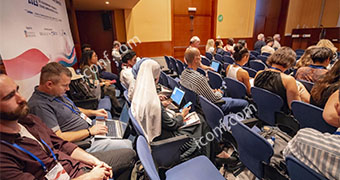

912 views||Release time: Dec 19, 2024
Publishing your research paper at an academic conference is an important step in sharing your work with the global academic community. It provides you with visibility, feedback from experts, and networking opportunities. Whether you’re presenting for the first time or looking to enhance your academic profile, understanding the submission process is crucial to your success. In this guide, we will walk you through the steps involved in submitting and publishing a paper at an academic conference, with a focus on conferences hosted on iconf.com.
Before submitting your paper, it's essential to ensure it is well-prepared. Here are the steps involved:
Each conference has a specific theme or focus area. Before starting your paper, ensure that your research aligns with the conference’s objectives. For example, if the conference focuses on "Advancements in Artificial Intelligence," your paper should contribute to this theme in a meaningful way.
Each conference will provide specific guidelines for paper submission, including formatting, length, and structure. Pay close attention to these instructions to avoid rejection due to technicalities. Common requirements include:
Title, abstract, and keywords
Paper length (usually between 4,000-6,000 words)
Referencing style (e.g., APA, IEEE, Chicago)
File format (PDF, DOCX, etc.)
Tip: Download the official submission template (if provided) and follow it carefully to ensure your paper meets all requirements.
Write a clear, concise, and well-structured paper. Make sure it presents a solid argument, includes appropriate literature review, and clearly explains your methodology and results. After drafting your paper, review it multiple times for clarity, accuracy, and grammar.
Once your paper is prepared, it’s time to submit it. The submission process is straightforward but requires careful attention to detail.
Before submitting your paper, you’ll likely need to create an account on the conference platform (such as iconf.com). This will allow you to upload your paper, track submission status, and receive updates regarding your submission.
Follow the submission instructions on the conference platform. Typically, this involves:
Some conferences charge a submission or registration fee. If applicable, make sure to complete the payment process promptly to confirm your submission.
After submitting your paper, it will undergo a peer review process. This is a critical stage that can influence the acceptance of your paper.
Your paper will be evaluated by a panel of experts in the field who will assess the quality of your research, its relevance to the conference theme, and its contribution to the academic community. Reviewers will provide feedback on your methodology, data analysis, and conclusions.
The review process typically results in one of the following outcomes:
Accepted with Minor Revisions: You may be asked to make small adjustments to improve clarity or address reviewers' concerns.
Accepted with Major Revisions: Significant changes may be required, such as refining your analysis or adding more details to certain sections.
Rejected: If the paper does not meet the required standards or scope, it may be rejected. If rejected, use the feedback to improve your work for submission elsewhere.
Tip: Be prepared to make revisions, as feedback from reviewers often improves the quality of your paper.
If your paper is accepted, the next steps involve finalizing your submission and preparing for the conference presentation.
If your paper was accepted with revisions, make sure to submit the final version by the given deadline. Ensure all reviewer comments have been addressed thoroughly, and your paper is polished for presentation.
For conferences that require a presentation, prepare slides or visual aids to complement your paper. Focus on key findings, methodology, and implications of your research.
Once your paper is accepted and you’re ready to present, attending the conference itself is a crucial part of the process.
Conferences provide an excellent opportunity to network with other researchers, professionals, and scholars. Take time to attend other sessions, ask questions, and engage in discussions to expand your academic network.
When presenting, focus on delivering a clear and engaging overview of your research. Be prepared to answer questions from the audience and engage in academic discussions.
After the conference, there may be opportunities to publish your paper in the conference proceedings or a special issue of a related academic journal.
If the conference has a proceedings publication, your paper may be included if it has been accepted. Follow the platform’s submission instructions, and ensure your final paper is formatted according to the publication standards.
Some conferences also offer opportunities to submit your work to a special issue of an academic journal. This is an excellent way to expand the reach of your research.
Publishing your paper at an academic conference is a rewarding process that helps you gain visibility, receive valuable feedback, and expand your network. By following this step-by-step guide, you can navigate the submission process smoothly and increase your chances of success. Whether you're attending in-person or virtually, platforms like iconf.com offer a user-friendly interface for submitting and presenting your research.
For upcoming conferences and submission opportunities, visit iconf.com and stay updated on the latest events in your field.

Start submitting your paper to the next academic conference at iconf.com today!